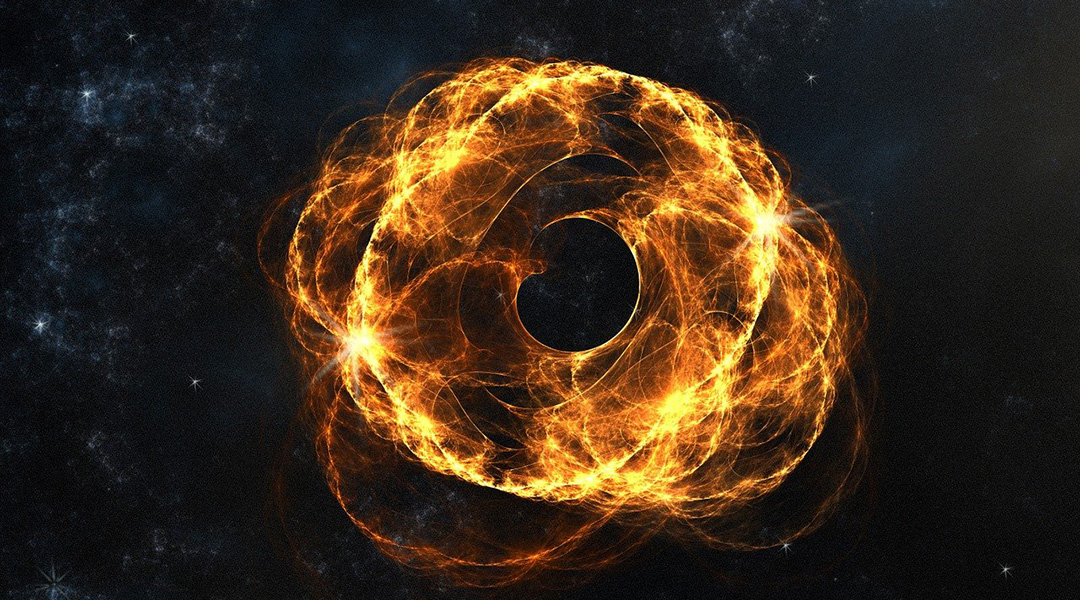Black holes are best known for their extreme gravitational pull, which is so powerful that nothing, not even light can escape once it passes their surface called the event horizon — a point of no return.
But according to a popular theory developed by Stephen Hawking, black holes are not, well, complete black holes. They do in fact emit radiation, called Hawking radiation, due to quantum effects in which particles are created directly from empty space above the event horizon. As a result, black holes are expected to lose their mass over time, eventually evaporating completely.
While Hawking radiation is a well-accepted prediction, it has not yet been observed directly due to its incredibly weak nature, especially for large astrophysical black holes. Additionally, the time it would take for a black hole to evaporate is orders of magnitude longer than the current age of the Universe.
A recent study has suggested that during the tumultuous mergers of black holes or neutron stars, smaller black holes, called morsels, could be produced which might emit Hawking radiation that is detectable with existing technology due to their smaller size.
“It was a surprise to find that black hole morsels can radiate above the detection capabilities of current […] telescopes on Earth,” Giacomo Cacciapaglia, lead author of the study from the Université Lyon Claude Bernard 1 in France, said in an article published on Phys.org.
Mergers, morsels, and Hawking radiation
In 1974, Stephen Hawking revolutionized our understanding of black holes by combining Einstein’s theory of general relativity with quantum theory of radiation. He predicted that the gravitational field of a black hole should cause the creation of particles — mostly photons — directly from the vacuum of space.
Despite being groundbreaking, Hawking’s theory also suggested this radiation from typical black holes, formed from collapsing stars, would be undetectable. Because the strength of this radiation is inversely proportional (to the fourth power) to the black hole’s mass — making it exceptionally weak and undetectable with current detectors.
This makes the radiation of a black hole many orders of magnitude weaker than what can be detected using Earth-based detectors.
In their preprint study, which has not yet gone through peer review, the team described the formation of these black hole morsels, but didn’t detail all aspects of their formation due to the complexity of Einstein’s equations. Instead, they considered various possible masses and numbers of these objects generated during such violent collisions.
They found that asteroid-mass morsels, plausible following the merger of real black holes, would emit their energy in just a few hours (not ages of the Universe as in the case of black holes the size of stars), leading to bursts of ultra-high-energy gamma rays, similar to those from supernova explosions, which have already been successfully recorded using ground-based detectors like HESS, HAWC, and LHAASO.
“If the proposed signal is observed, we will have to question the current knowledge of the nature of black holes and morsel production,” said Cacciapaglia.
Hawking’s theory does not deal with the process of how black holes form, only that an already formed black hole will emit radiation. When analyzing black hole mergers, the possible production of morsels is not typically considered, meaning that if their radiation can be observed, this will not only provide confirmation of Hawking’s prediction, but prove the existence of morsels as well.
Additionally, studying this radiation could advance our understanding of quantum gravity, a sought after theory in modern theoretical physics. Hawking’s calculations treated black holes using classical general relativity, which does not incorporate quantum gravity. Therefore, any differences between observed radiation and Hawking’s predictions could reveal these quantum effects in gravity.
An interesting theory if black hole morsels exist…
While an interesting concept, not everyone is convinced that morsels will be the answer to Hawking’s prediction.
“In my view, there is no viable theory which would lead to the formation of such ‘morsels’, and it is quite unlikely that they exist,” Badri Krishnan, a professor of physics at the Radboud University who was not involved in the study, said in an email.
Moreover, the team assumed all morsels have the same mass and do not rotate. Given what we know about stellar-mass black holes, this is unlikely, although it is not expected to radically change the emission power of the morsels.
“It’s fine though from an observational standpoint to try and look for them and to set constraints on their properties, and in this regard the assumptions about masses and rotation are important,” continued Krishnan. “Over time, I would expect that the LIGO observations should lead to tighter constraints on the maximum mass possible for such morsels.”
Despite these challenges, the authors remain optimistic that detailed comparisons will soon be possible to help determine if black holes do emit radiation as Hawking predicted, offering a powerful new method for studying fundamental particles and interactions.
Reference: Giacomo Cacciapaglia et al, Measuring Hawking Radiation from Black Hole Morsels in Astrophysical Black Hole Mergers, arXiv (2024). DOI: 10.48550/arxiv.2405.12880
Feature image credit: insspirito on Pixabay

















